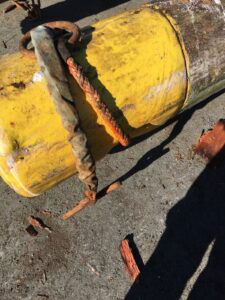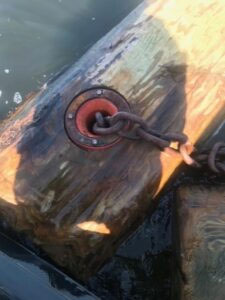Water transport of logs is a cost-effective means of log transport where there is water access. This is done within booms, built using long logs, or “boomsticks”, chained together to hold log bundles within the boom during storage and transport.
 However, boomsticks deteriorate over time, primarily due to marine borer infestation and degradation of the bored end holes. This results in replacement costs for British Columbia’s costal forest industry that can reach $12 million annually. These costs, along with the shortage of suitable logs, led FPInnovations to examine ways of improving boomstick service life.
However, boomsticks deteriorate over time, primarily due to marine borer infestation and degradation of the bored end holes. This results in replacement costs for British Columbia’s costal forest industry that can reach $12 million annually. These costs, along with the shortage of suitable logs, led FPInnovations to examine ways of improving boomstick service life.
Using poly sleeves and synthetic ropes
Boomsticks are made from logs with a hole bored at either end to accommodate the boom chain. An initial study by FPInnovations already examined preservatives treatment to extend life service of boomsticks and prevent marine borer attack. FPInnovations recently conducted a short-term study that assessed the potential application of poly sleeves and synthetic ropes.
 For this study, FPInnovations’ Transportation and Infrastructures team used polyurethane sleeves that were inserted into the boomstick end holes to reduce boom chain-caused wear and tear. As for the synthetic rope, it was made from ultra-high molecular weight polyethylene (UHMWPE) fiber, a lighter weight alternative to steel chains.
For this study, FPInnovations’ Transportation and Infrastructures team used polyurethane sleeves that were inserted into the boomstick end holes to reduce boom chain-caused wear and tear. As for the synthetic rope, it was made from ultra-high molecular weight polyethylene (UHMWPE) fiber, a lighter weight alternative to steel chains.
For each component, the study examined the technical, economics, and environmental metrics. Overall, the tests showed that the use of poly sleeves and a synthetic rope provided longer service life when used with treated boomsticks, leading to potential annual savings of $370,000 for the coastal forest industry. It was also determined that all material could be reused or recycled at end of life.
Pursuing trials for additional benefits
It is expected that boom worker injuries could be reduced with the use of synthetic ropes since they are much lighter and easier to handle than heavy steel boom chains.
Further trials are needed to determine if these ropes can be used in towing applications over the long term. Tracking systems and technologies need to be developed and implemented to ensure companies can maintain ownership of their poly sleeve boomsticks.
For more information, contact
Source: FPInnovations













